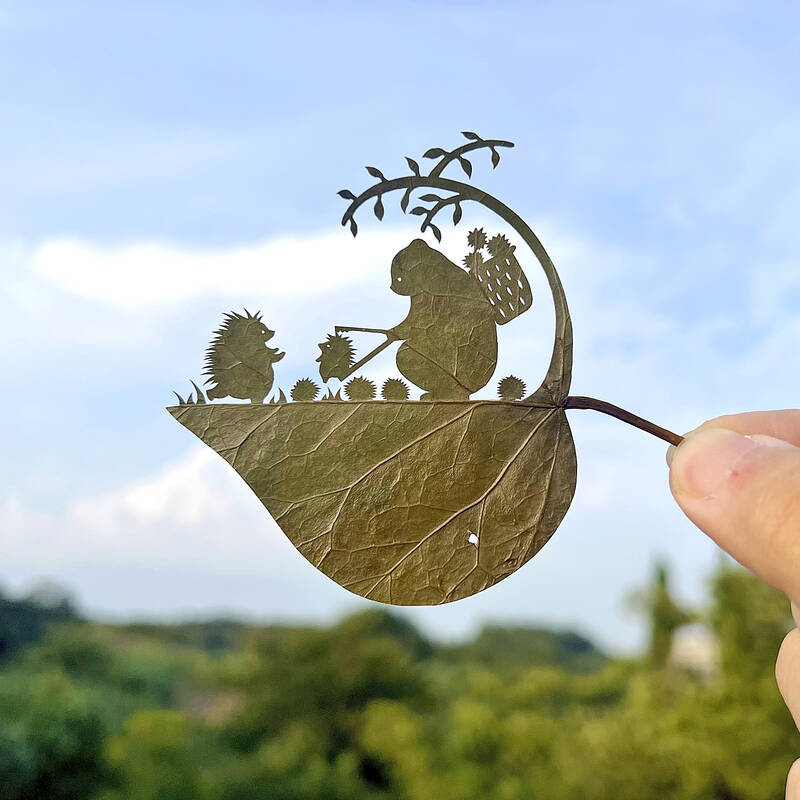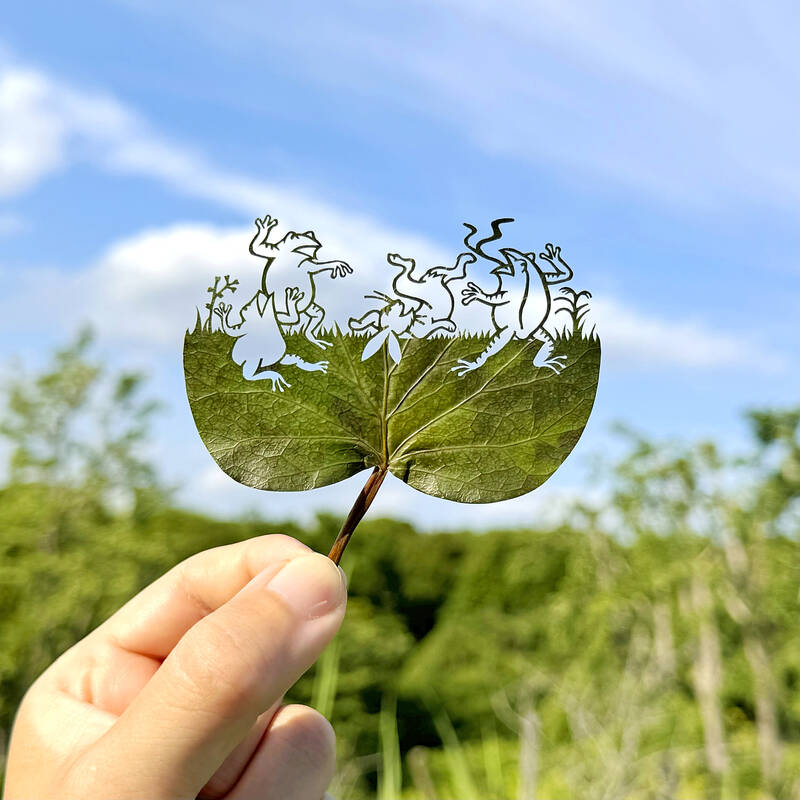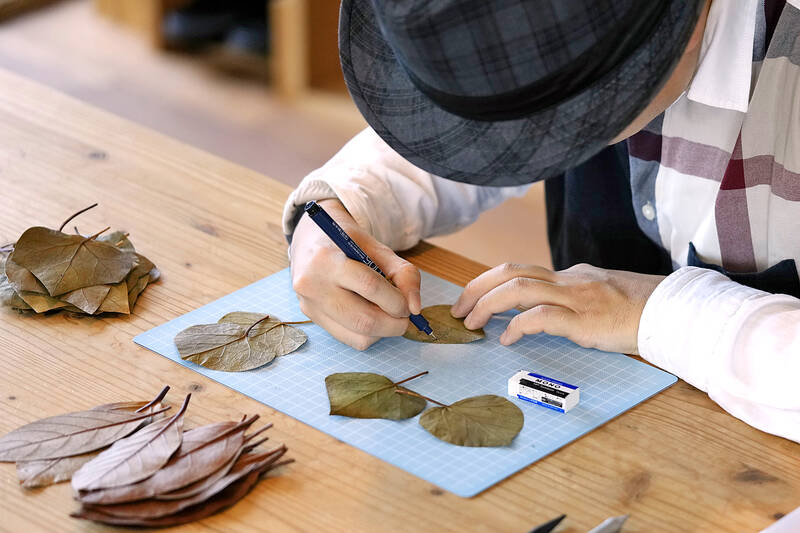A frog holding a taro-leaf umbrella. A parade of frolicking animals. An Ukiyo-e style Mount Fuji. Giant waves. A Japanese artist who goes by the name Lito carves these delicate designs on fallen leaves, giving life back to them.
The world of Lito’s delicate art, which he began in 2020 and posts on social media almost daily, has won fans from around the world. The leaf art has also given him solace after earlier struggles with attention-deficit hyperactivity disorder, and a purpose in life — the joy of making people happy with his art.
He enjoys working at night. From a pile of leaves treated with a wrinkle-free chemical, he picks one and places it on a cutting board.

Photo: AP
First, he outlines the design on the leaf with a pen in his right hand. Then he takes a design knife in his left hand and starts cutting the leaf carefully. Slowly, the leaf begins to take the shape of a frog carrying an umbrella — a simple design he recently demonstrated.
More complex, highly intensive work on a single leaf can take more than eight hours to complete.
His leaf-cutting works include titles such as Scrolls of Frolicking Animals, Leaf Aquarium, and Thirty-six Views of Mt. Fuji: The Great Wave off Kanagawa. Each piece includes his own twists, and often uses animals.

Photo: AP
“I would rather finish it in one go when I am focused,” Lito, 38, said. He didn’t want to disclose his real name for personal reasons.
Since his childhood, Lito says he has had high levels of concentration and patience. But he had trouble fitting into what was considered the norm at school or at work, despite all his efforts. He struggled to interpret others’ feelings and to avoid confrontations.
After years of difficulty, he went to a hospital at age 30 and was told he has ADHD, a diagnosis that he felt explained why he has always done things differently.

Photo: AP
He saw no point in forcing himself to do things the same way as other people, and began to adjust his life.
In early 2020, Lito came across the art of leaf cutting. He saw it as the perfect use of his patience and concentration.
Word of his skills has spread across social media, and he has published books on his leaf-cutting work. He holds a near monthly solo exhibition in various places in Japan.

Photo: AP
“If I can make people happy by doing what I am doing, I want to do more. That’s my driving force for what’s next,” Lito says.

One of the biggest sore spots in Taiwan’s historical friendship with the US came in 1979 when US president Jimmy Carter broke off formal diplomatic relations with Taiwan’s Republic of China (ROC) government so that the US could establish relations with the People’s Republic of China (PRC). Taiwan’s derecognition came purely at China’s insistence, and the US took the deal. Retired American diplomat John Tkacik, who for almost decade surrounding that schism, from 1974 to 1982, worked in embassies in Taipei and Beijing and at the Taiwan Desk in Washington DC, recently argued in the Taipei Times that “President Carter’s derecognition

This year will go down in the history books. Taiwan faces enormous turmoil and uncertainty in the coming months. Which political parties are in a good position to handle big changes? All of the main parties are beset with challenges. Taking stock, this column examined the Taiwan People’s Party (TPP) (“Huang Kuo-chang’s choking the life out of the TPP,” May 28, page 12), the Democratic Progressive Party (DPP) (“Challenges amid choppy waters for the DPP,” June 14, page 12) and the Chinese Nationalist Party (KMT) (“KMT struggles to seize opportunities as ‘interesting times’ loom,” June 20, page 11). Times like these can

You can tell a lot about a generation from the contents of their cool box: nowadays the barbecue ice bucket is likely to be filled with hard seltzers, non-alcoholic beers and fluorescent BuzzBallz — a particular favorite among Gen Z. Two decades ago, it was WKD, Bacardi Breezers and the odd Smirnoff Ice bobbing in a puddle of melted ice. And while nostalgia may have brought back some alcopops, the new wave of ready-to-drink (RTD) options look and taste noticeably different. It is not just the drinks that have changed, but drinking habits too, driven in part by more health-conscious consumers and

Dr. Y. Tony Yang, Associate Dean of Health Policy and Population Science at George Washington University, argued last week in a piece for the Taipei Times about former president Ma Ying-jeou (馬英九) leading a student delegation to the People’s Republic of China (PRC) that, “The real question is not whether Ma’s visit helps or hurts Taiwan — it is why Taiwan lacks a sophisticated, multi-track approach to one of the most complex geopolitical relationships in the world” (“Ma’s Visit, DPP’s Blind Spot,” June 18, page 8). Yang contends that the Democratic Progressive Party (DPP) has a blind spot: “By treating any